
Chalcid wasps are insects within the superfamily Chalcidoidea, part of the order Hymenoptera. The superfamily contains some 22,500 known species, and an estimated total diversity of more than 500,000 species, meaning the vast majority have yet to be discovered and described. The name "chalcid" is often confused with the name "chalcidid", though the latter refers strictly to one constituent family, the Chalcididae, rather than the superfamily as a whole; accordingly, most recent publications (e.g.,) use the name "chalcidoid" when referring to members of the superfamily.

Apocrita is a suborder of insects in the order Hymenoptera. It includes wasps, bees, and ants, and consists of many families. It contains the most advanced hymenopterans and is distinguished from Symphyta by the narrow "waist" (petiole) formed between the first two segments of the actual abdomen; the first abdominal segment is fused to the thorax, and is called the propodeum. Therefore, it is general practice, when discussing the body of an apocritan in a technical sense, to refer to the mesosoma and metasoma rather than the "thorax" and "abdomen", respectively. The evolution of a constricted waist was an important adaption for the parasitoid lifestyle of the ancestral apocritan, allowing more maneuverability of the female's ovipositor. The ovipositor either extends freely or is retracted, and may be developed into a stinger for both defense and paralyzing prey. Larvae are legless and blind, and either feed inside a host or in a nest cell provisioned by their mothers.

The family Agaonidae is a group of pollinating fig wasps. They spend their larval stage inside the fruits of figs. The pollinating wasps are the mutualistic partners of the fig trees. Extinct forms from the Eocene and Miocene are nearly identical to modern forms, suggesting that the niche has been stable over geologic time.
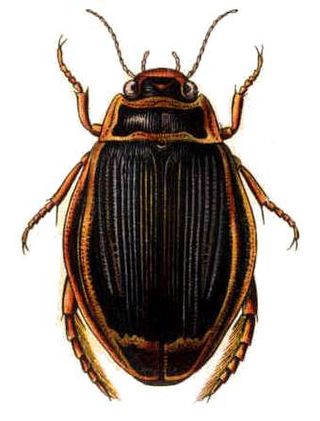
Dytiscus is a Holarctic genus of predaceous diving beetles that usually live in wetlands and ponds. There are 26 species in this genus distributed in Europe, Asia, North Africa and North and Central America. They are predators that can reduce mosquito larvae.

The organ pipe mud dauber is a predatory wasp in the family Crabronidae. It is fairly large, ranging from 3.9–5.1 cm, and has been recorded to fly from May to September. Females and males are similar in colour, a shiny black, with the end part of the back leg being pale yellow to white.

The Mymaridae, commonly known as fairyflies or fairy wasps, are a family of chalcidoid wasps found in temperate, subtropical, and tropical regions throughout the world. The family contains around 100 genera with 1,400 species.
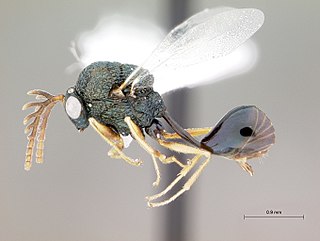
The Eucharitidae are a family of parasitic wasps. Eucharitid wasps are members of the superfamily Chalcidoidea and consist of four subfamilies: Akapalinae, Eucharitinae, Gollumiellinae, and Oraseminae. Most of the 42 genera and >400 species of Eucharitidae are members of the subfamilies Oraseminae and Eucharitinae, and are found in tropical regions of the world.
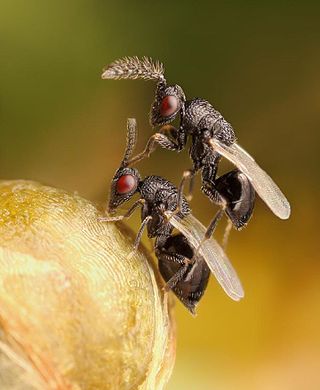
The Eurytomidae are a family within the superfamily Chalcidoidea.

Alexandre Arsène Girault was an American entomologist specializing in the study of chalcid wasps. An eccentric and controversial figure, Girault was also a prolific and dedicated entomologist. He published more than 325 papers and described over 3000 new taxa from Australia.
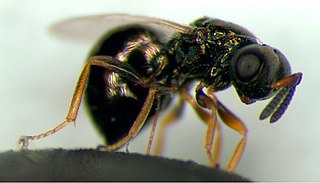
Nasonia vitripennis is one of four known species under the genus Nasonia - small parasitoid wasps that afflict the larvae of parasitic carrion flies such as blowflies and flesh flies, which themselves are parasitic toward nestling birds. It is the best known and most widely studied of the parasitoid wasps, and their study forms a vital part of the information used to describe the order Hymenoptera, along with information from bees and ants. This parasitoid behaviour makes the wasps an interest for the development of biopesticide and biological systems for controlling unwanted insects.
Baeoentedon is a genus of hymenopteran insects of the family Eulophidae, they are parasitoids of whitefly from the family Aleyrodidae which are found on trees of the genus Ficus. They have been recorded from Australia, China, India, Indonesia and Florida. A fifth species, Baeoentodon farazi, was described from Karnataka, India, in 2017.
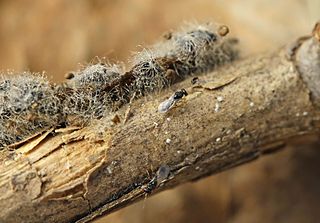
Euplectrus is a genus of hymenopteran insects of the family Eulophidae.
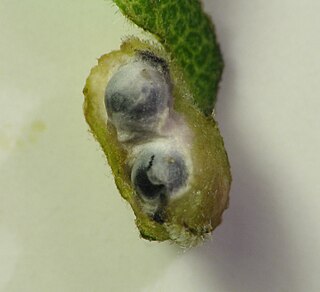
Galeopsomyia is a New World genus of hymenopteran insects of the family Eulophidae. The genus is a hyperparasitoid of other gall-inducing wasps of the genera Eurytoma and Torymus.
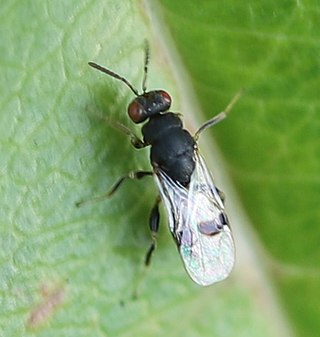
Sycophila is a genus of wasp in the family Eurytomidae that associates with figs and galls of various insects such as gall wasps and gall midges. It can be distinguished from other eurytomid genera by the elongate petiole, the gaster often being laterally compressed, and the forewing having a broadened marginal vein and dark brown maculae. Sycophila has a cosmopolitan distribution.

Pison spinolae, commonly known as mason wasp, is a solitary wasp of the family Crabronidae, native to Australia and found throughout New Zealand where it is an introduced species.
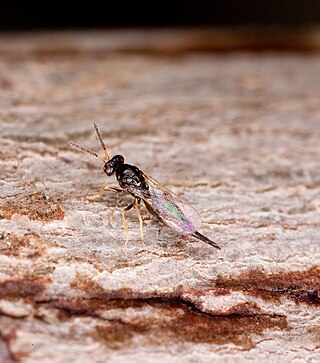
Tetrastichinae is a subfamily of the chalcid wasp family Eulophidae. It is one of the largest subfamilies of the Eulophidae containing over 100 genera and nearly 3,000 species. The species of the family Tetrastichinae are found in almost any type of terrestrial habitat and have a worldwide distribution, except Antarctica. They show a varied biology and hosts for Tetrastichinae wasps have been identified from over 100 different insect families, across 10 different orders and they have also been recorded as being parasitoids on nematodes, mites and spiders' eggs. Some species are even phytophagous, while others are inquilines and yet others are gall formers.
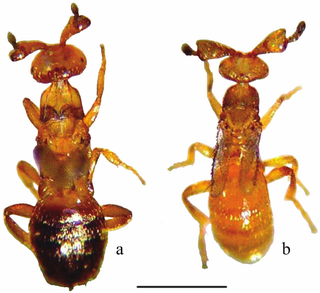
Melittobia australica is a species of chalcid wasp from the family Eulophidae which is a gregarious ecto-parasitoid of acuealate Hymenoptera.

Dirhinus is a genus of parasitic wasps in the family Chalcididae. The genus has a worldwide distribution.
Plutarchia is a genus of chalcid wasp in the subfamily Eurytominae. Alexandre Arsène Girault first circumscribed the genus in 1925; its name honors Plutarch. The genus initially only comprised its type species, P. bicarinativentris, found in Australia. Subsequent species from South Asia and Nigeria have been described and transferred to Plutarchia.
Baeoentedon bouceki is a species of wasp, one of the first three members of the genus Baeoentedon to be discovered in China. It is less than a millimetre in length, with a head slightly wider than the middle portion of the body. Only one specimen has been studied, collected from Hainan in 1983. As that specimen is female, the appearance of males is unknown.

















